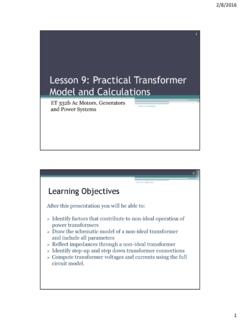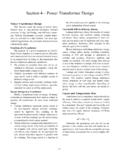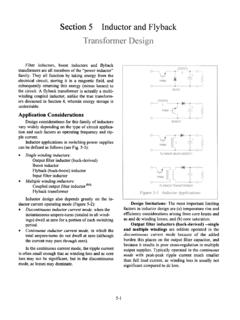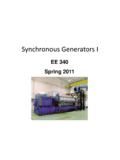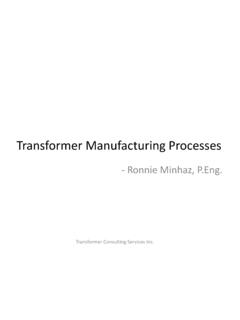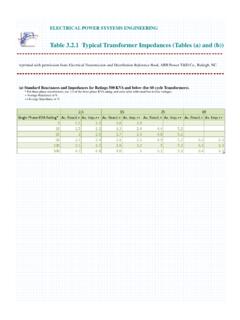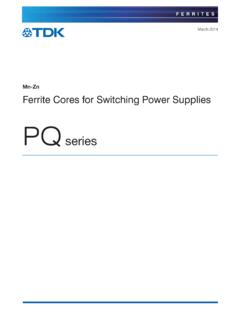Transcription of Transformer asics Information Guide - Motion Labs
1 Property of Motion Laboratories, Inc. Created By: Jim Herrick / Michael Shaw Approved By: Peter Herrmann Page: 1 2014 Motion Laboratories, Inc. Transformer Basics Information Guide Page: 2 2014 Motion Laboratories, Inc. Transformer Definition An electric device consisting essentially of two or more windings, wound on a common core, which by electromagnetic induction transfers electric energy from one set of windings (primary) to another set of windings (secondary). In addition to the basic Transformer design, there are other specialty configurations, such as, Buck/Boost, which are described in Types & Uses. While the voltage and current usually change (from primary to secondary), the frequency of the energy remains unchanged. transformers only work on alternating current (not direct current).
2 The voltage change is determined by the ratio of turns of wire around the core, between the primary and secondary windings. Page: 3 Information Guide Transformer Basics Table Of Contents 1. Normal Types & Uses 2. Multiple Taps 3. Reverse Connected 4. Metering 5. Single Phase 6. Three Phase 7. Delta / Wye (3-Phase) 8. Hertz (Hz) 9. International Considerations 10. What a Transformer Can t Do 11. KVA 12. Separately Derived Neutral / Ground Bond 13. Overload (Over-Current) Protection 14. Load Balancing 15. Sizing a Transformer Page: 4 Information Guide Transformer Basics 1. Normal Types & Uses Isolation only Does not change voltage. It does, however, provide isolation from the facilities electrical system, which eliminates much of the buildings electrical noise on the output.
3 Step down Changes a higher voltage to a lower voltage, such as 480V to 208V, and provides isolation. Step up Changes a lower voltage to a higher voltage, such as 240V to 480V, and provides isolation. Note: In most cases the transformers (describe above) that provide isolation also incorporate a grounded Faraday Shield , between the primary and secondary windings, to reduce the transmittance of high frequency noise . Although shielding is generally included, it should be specified. Buck/Boost Normally used when only a small change in voltage is required (20% or less), such as 208V to 240V (Boost) or 240V to 208V (Buck). This type system does not provide isolation, but is more cost effective if isolation is not required. A Buck/Boost Transformer is also referred to as an Auto Transformer .
4 On an Isolation Transformer there is no direct electrical connection between the primary and secondary (Only magnetic / inductive), such is not the case with a Buck/Boost unit, therefore there is no isolation. 2. Multiple Taps In order to accommodate various input voltages, some transformers may be equipped with multiple taps on the primary. These taps are sized for standard voltages (220, 230, ), or they can be only slight variations to adjust for consistent over or under voltage at a particular location. These taps are most commonly provided as a percentage of the primary voltage, such as 2-1/2% and 5% (up or down from nominal). (Primary Voltage/Tap Voltage Setting) X Expected Secondary Voltage = Actual Output Voltage For Example: Given a 480V to 208V Delta > Wye, with an input voltage of 460V and a tap set for 480V would yield: (460/480) X 208 = In order to yield 208V this tap setting would be insufficient.
5 You would have to use a tap setting that was lower, such as 456V. Page: 5 Information Guide Transformer Basics 3. Reverse Connected Most transformers can be reverse connected which means the same Transformer can be wired to be a step-up or step-down, depending on how it s installed. This reversing capability must be allowed and specified by the manufacturer. 4. Metering Although not absolutely required, it is recommended that an integral meter panel be installed in, or adjacent to, the Transformer enclosure. This will allow constant monitoring of system performance, and let you know if the required voltage is present and that the system is not being overloaded. 5. Single Phase A Transformer that is fed, on the primary winding , by a single alternating voltage, which can be represented by a single sine wave.
6 The secondary winding can be split or tapped , to produce multiple voltages, such as, 120/240V. If a Transformer connection is rearranged from step up to step down or step down to step up, careful attention must be paid to the neutral/ground bonding which can only be on the output side of the Transformer . Page: 6 Information Guide Transformer Basics 6. Three Phase A Transformer that is fed, on the primary windings, by three equal alternating voltages, the timing of which are 120 degrees out of phase with each other. A typical application would be 480V input with 120/208V output, where the grounded conductor (neutral) on the 120V output is common with all three lines (Phases). A three phase Transformer can be constructed either by connecting together three single-phase transformers , thereby forming a so-called three phase Transformer bank, or by using one pre-assembled, three phase Transformer which consists of three pairs of single phase windings mounted onto one single laminated core.
7 The advantages of building a single three phase Transformer is that for the same kVA rating it will be smaller, less expensive, and lighter than three individual single phase transformers connected together because the copper and iron core are used more effectively. Page: 7 Information Guide Transformer Basics 7. Delta / Wye (3-Phase) There are two types of circuits used to maintain equal load across the three hot wires in a 3-phase system Delta and Wye. The Delta configuration has the three phases connected like a triangle, whereas the Wye (or star ) configuration has all three loads connected at a single neutral point. In most cases Delta systems have four wires three hot and one ground. Wye systems have five wires three hot, one neutral and one ground.
8 While both Delta and Wye systems can measure 208 VAC (on the secondary) between any two hot wires, Wye systems also measure 120 VAC between any hot wire and neutral. In other words, it s the neutral wire of the Wye system that provides two different voltages for powering both 3-phase (208V) and single-phase (120V) devices. Types The most common 3-phase configuration is: Delta > Wye, (Depicted below), Page: 8 Information Guide Transformer Basics 7. Delta / Wye (3-Phase) ( ) In addition, there are other configurations available, such as: Delta > Delta, used when a neutral is generally not required on the secondary. If a secondary neutral is provided, it is termed a High Leg system, since one of the legs (referenced to ground), would be in excess of 200V.
9 It is not recommended that a neutral be provided with a Delta secondary, since the High Leg can cause equipment damage if not connected properly. Wye > Wye, in this case a neutral is not required on the primary, however this is a more expensive configuration, without any benefit other than being able to rearrange input and output. (As described in Section 3) Wye > Delta, This configuration is not recommended, due to its instability with unbalanced loads and it contributes to additional harmonic content. 8. Hertz (Hz) Also termed Cycles per Second or Frequency . With relation to sine waves, it s the time it takes for one complete cycle. In North America the frequency is 60Hz, in most of Europe it s 50Hz. transformers must be specified at which frequency they will be used.
10 A Transformer that is rated at 50Hz will also operate at 60Hz, however the inverse is not true: A 60Hz rated Transformer cannot operate at 50Hz, unless de-rated at least 20% to allow for excessive heating effects. This is NOT recommended and these applications require a Transformer rated for 50hz/60hz. Page: 9 Information Guide Transformer Basics 9. International Considerations Different countries have different standard voltages depending on the location. In most of Europe the standard voltages include 380V & 415V, but this may vary considerably. It is difficult, if not impossible, to get a Transformer with all the possible voltages you may encounter, and additionally more difficult to get one that has both North American and European voltages on the same Transformer .
